Energy Efficiency Perspectives of PMR Networks †
Abstract
:1. Introduction
2. Present and Future PMR Systems
2.1. TETRA and TEDS for Speech and Data Communications
- group calls;
- reduced call set-up time (below 300 ms) with respect to 2G technologies;
- direct mode of operation using other mobile devices as repeaters;
- secure data transmission by end-to-end encryption;
- push-to-talk mode.
- Air Interface (AIR I/F), which ensures the interoperability of terminal equipment of different manufacturers;
- Terminal Equipment Interface (TEI) facilitating the independent development of mobile data applications;
- Inter Systems Interface (ISI), which allows the interconnection between TETRA networks of different manufacturers;
- Direct Mode Operation (DMO) guaranteeing the communication between terminals also beyond network coverage.
2.2. The PMR Evolution through the LTE System
- Group communication and push-to-talk (PTT),
- Proximity based services,
- Network resilience,
- High power user equipments,
- Enhanced Radio Access Network (RAN) sharing,
- Priority and Quality of Service (QoS) control.
3. Modelling Power Consumption in PMR Systems
4. Energy Efficiency Strategies for PMR Systems
4.1. Carrier Sleep Mode
4.2. BCCH Carrier Power Control
5. Technical and Economic Considerations on Energy Efficiency of Next Generation PMR Systems
5.1. Business Models for Mobile Broadband PMR
5.1.1. Contract Services through an Existing Mobile Network Operator
5.1.2. Obtain Service from a Government Mobile Virtual Network Operator
5.1.3. Deploy Dedicated Network Services through a Public-Private Partnership Project
5.1.4. Build, Own and Operate a Dedicated Private Network
5.1.5. Combine a G-MVNO with a Private Network (Hybrid Model)
5.2. LTE Energy Efficiency Gain
5.3. Radio Resource Management Strategies for Energy Efficiency
6. Conclusions
Author Contributions
Conflicts of Interest
References
- TETRA and Critical Communications Association. The Strategic Case for Mission Critical Mobile Broadband—A Review of the Future Needs of the Users of Critical Communications; White Paper; TETRA and Critical Communications Association: Newcastle upon Tyne, UK, 2013. [Google Scholar]
- Gruet, C.; Pons-Masbernat, X.; Force, P. The LTE Evolution: Private Mobile Radio Networks. IEEE Veh. Technol. Mag. 2013, 8, 64–70. [Google Scholar] [CrossRef]
- Lasanen, M.; Aubree, M.; Cassan, C.; Conte, A.; David, J.; Elayoubi, S.E.; Galkin, T.; Grigore, V.; Le Masson, S.; Lees, J.; et al. Environmental friendly mobile radio networks: Approaches of the European OPERA-Net 2 project. In Proceedings of the 20th International Conference on Telecommunications (ICT), Casablanca, Morocco, 6–8 May 2013; pp. 1–5.
- Meo, M.; Zhang, Y.; Hu, Y.; Idzikowski, F.; Budzisz, L.; Ganji, F.; Haratcherev, I.; Conte, A.; Cianfrani, A.; Chiaraviglio, L.; et al. The TREND experimental activities on green communication networks. In Proceedings of the 24th Tyrrhenian International Workshop on Digital Communications—Green ICT (TIWDC), Genoa, Italy, 23–25 September 2013; pp. 1–6.
- Olsson, M.; Fehske, A.; Hevizi, L.; Blume, O.; Vidacs, A.; Godor, I.; Fazekas, P.; Imran, M.; Qi, Y. Integration strategy of EARTH energy efficiency enablers. In Proceedings of the Future Network Mobile Summit (FutureNetw), Berlin, Germany, 4–6 July 2012; pp. 1–8.
- Olsson, M.; Cavdar, C.; Frenger, P.; Tombaz, S.; Sabella, D.; Jantti, R. 5GrEEn: Towards Green 5G mobile networks. In Proceedings of the IEEE 9th International Conference on Wireless and Mobile Computing, Networking and Communications (WiMob), Lyon, France, 7–9 October 2013; pp. 212–216.
- Bianco, C.; Cucchietti, F.; Griffa, G. Energy consumption trends in the next generation access network, a telco perspective. In Proceedings of the 29th International Telecommunications Energy Conference (INTELEC), Rome, Italy, 30 September–4 October 2007; pp. 737–742.
- Davaslioglu, K.; Ayanoglu, E. Quantifying Potential Energy Efficiency Gain in Green Cellular Wireless Networks. IEEE Commun. Surv. Tutor. 2014, 16, 2065–2091. [Google Scholar] [CrossRef]
- Morosi, S.; Piunti, P.; Del Re, E. Improving cellular network energy efficiency by joint management of sleep mode and transmission power. In Proceedings of the 24th Tyrrhenian International Workshop on Digital Communications—Green ICT (TIWDC), Genoa, Italy, 23–25 September 2013; pp. 1–6.
- Chen, T.; Yang, Y.; Zhang, H.; Kim, H.; Horneman, K. Network energy saving technologies for green wireless access networks. IEEE Wirel. Commun. 2011, 18, 30–38. [Google Scholar] [CrossRef]
- Feng, D.; Jiang, C.; Lim, G.; Cimini, L.J.J.; Feng, G.; Li, G. A survey of energy-efficient wireless communications. IEEE Commun. Surv. Tutor. 2013, 15, 167–178. [Google Scholar] [CrossRef]
- Wu, J.; Zhou, S.; Niu, Z. Traffic-Aware Base Station Sleeping Control and Power Matching for Energy-Delay Tradeoffs in Green Cellular Networks. IEEE Trans. Wirel. Commun. 2013, 12, 4196–4209. [Google Scholar] [CrossRef]
- Del Re, E.; Morosi, S.; Piunti, P.; Mazzi, G.; Gremigni, O. Energy efficient RRM strategies for current and upcoming TeTRA cellular systems. In Proceedings of the IEEE 10th International Conference on Wireless and Mobile Computing, Networking and Communications (WiMob), Lyon, France, 8–10 October 2014; pp. 40–44.
- Ketterling, H.P.A. Introduction to Digital Professional Mobile Radio; Artech House, Inc.: Norwood, MA, USA, 2004. [Google Scholar]
- European Telecommunications Standards Institute. Terrestrial Trunked Radio (TETRA); Voice plus Data (V+D); Designers’ Guide; Part 1: Overview, Technical Description and Radio Aspects; ETSI Technical Report 300-1; ETSI: Sophia Antipolis, France, 1997. [Google Scholar]
- European Telecommunications Standards Institute. Terrestrial Trunked Radio (TETRA); Voice plus Data (V+D); Part 2: Air Interface; ETSI Technical Report 392-2; ETSI: Sophia Antipolis, France, 2001. [Google Scholar]
- Nouri, M.; Lottici, V.; Reggiannini, R.; Ball, D.; Rayne, M. TEDS: A high speed digital mobile communication air interface for professional users. IEEE Veh. Technol. Mag. 2006, 1, 32–42. [Google Scholar] [CrossRef]
- Doumi, T.; Dolan, M.; Tatesh, S.; Casati, A.; Tsirtsis, G.; Anchan, K.; Flore, D. LTE for public safety networks. IEEE Commun. Mag. 2013, 51, 106–112. [Google Scholar] [CrossRef]
- Ulema, M.; Kaplan, A.; Lu, K.; Amogh, N.; Kozbe, B. Critical communications and public safety networks, part 2: Technical issues, security, and applications. IEEE Commun. Mag. 2016, 54, 14–15. [Google Scholar] [CrossRef]
- Ferrus, R.; Sallent, O. Extending the LTE/LTE-A Business Case: Mission- and Business-Critical Mobile Broadband Communications. IEEE Veh. Technol. Mag. 2014, 9, 47–55. [Google Scholar] [CrossRef]
- 3rd Generation Partnership Project. Feasibility Study for Proximity Services (ProSe); 3GPP TR 22.803; 3GPP: Sophia Antipolis, France, 2014. [Google Scholar]
- 3rd Generation Partnership Project. Study on Architecture Enhancements to Support Group Communication System Enablers for LTE (GCSE LTE); 3GPP TR 23.768; 3GPP: Sophia Antipolis, France, 2014. [Google Scholar]
- 3rd Generation Partnership Project. Study on LTE Device to Device Proximity Services; Radio Aspects; 3GPP TR 36.843; 3GPP: Sophia Antipolis, France, 2014. [Google Scholar]
- 3rd Generation Partnership Project. Study on Isolated Evolved Universal Terrestrial Radio Access Network (E-UTRAN) Operation for Public Safety; 3GPP TR 22.897; 3GPP: Sophia Antipolis, France, 2014. [Google Scholar]
- 3rd Generation Partnership Project. Study on Radio Access Network (RAN) Sharing Enhancements; 3GPP TR 22.852; 3GPP: Sophia Antipolis, France, 2014. [Google Scholar]
- 3rd Generation Partnership Project. Public Safety Broadband High Power User Equipment (UE) for Band 14; 3GPP TR 36.837; 3GPP: Sophia Antipolis, France, 2007. [Google Scholar]
- 3rd Generation Partnership Project. Enhancements for Multimedia Priority Service (MPS); 3GPP TR 23.854; 3GPP: Sophia Antipolis, France, 2012. [Google Scholar]
- Auer, G.; Giannini, V.; Desset, C.; Godor, I.; Skillermark, P.; Olsson, M.; Imran, M.; Sabella, D.; Gonzalez, M.; Blume, O.; et al. How much energy is needed to run a wireless network? IEEE Wirel. Commun. 2011, 18, 40–49. [Google Scholar] [CrossRef]
- TETRA and Critical Communications Association. Mobile Broadband for Critical Communications Users—A Review of Options For Delivering Mission Critical Solutions; Technical Report; TETRA and Critical Communications Association: Newcastle upon Tyne, UK, 2013. [Google Scholar]
- Auer, G.; Blume, O.; Giannini, V.; Godor, I.; Imran, M.; Jading, Y.; Katranaras, E.; Olsson, M.; Sabella, D.; Skillermark, P.; et al. D2.3: Energy Efficiency Analysis of the Reference Systems, Areas of Improvements And Target Breakdown. INFSOICT-247733 EARTH (Energy Aware Radio and neTwork tecHnologies), Tech. Rep. 2010. Available online: http://cordis.europa.eu/docs/projects/cnect/3/247733/080/deliverables/001-EARTHWP2D23v2.pdf (accessed on 23 December 2016).
- Tombaz, S.; wook Han, S.; Sung, K.W.; Zander, J. Energy Efficient Network Deployment With Cell DTX. IEEE Commun. Lett. 2014, 18, 977–980. [Google Scholar] [CrossRef]
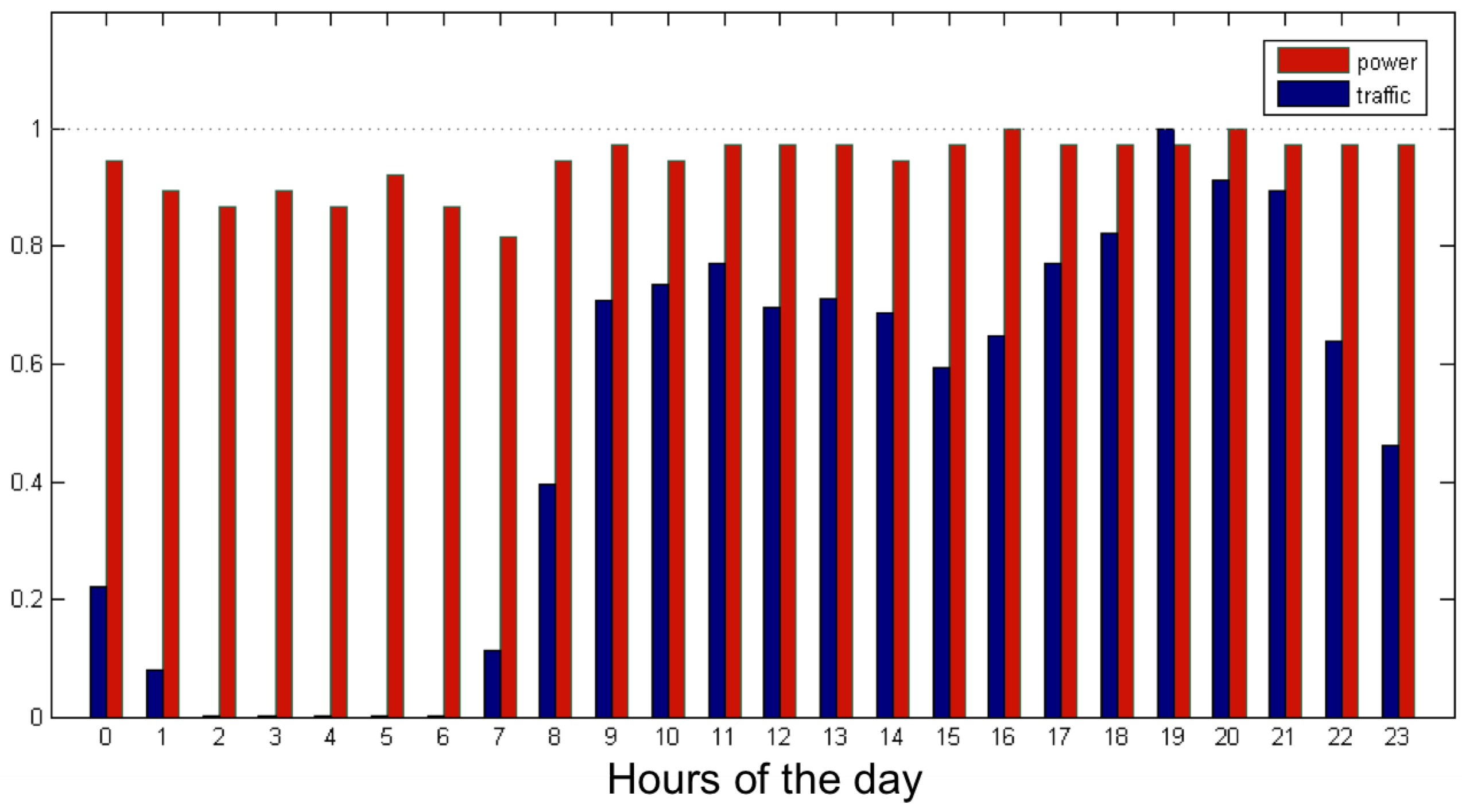
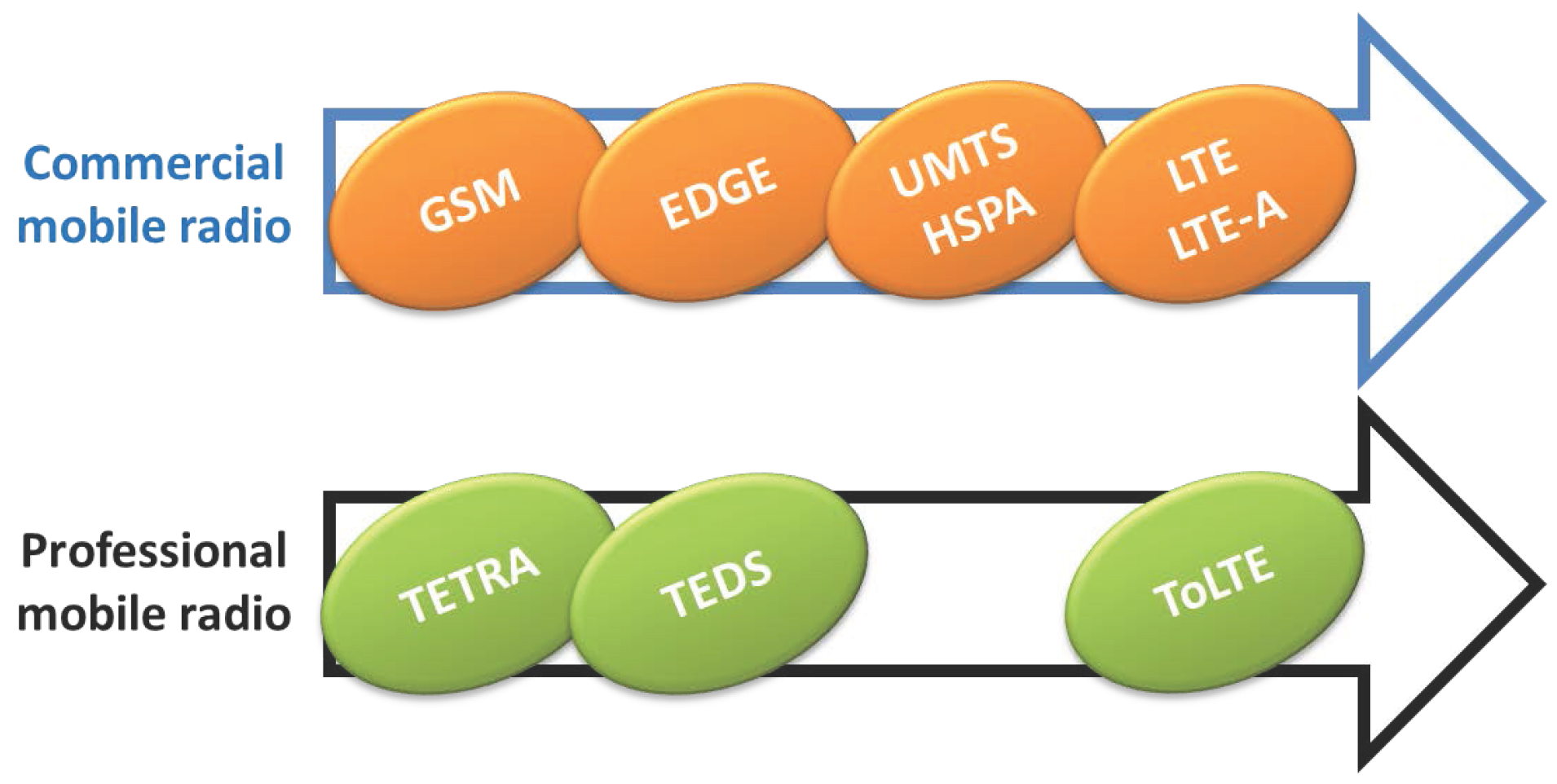



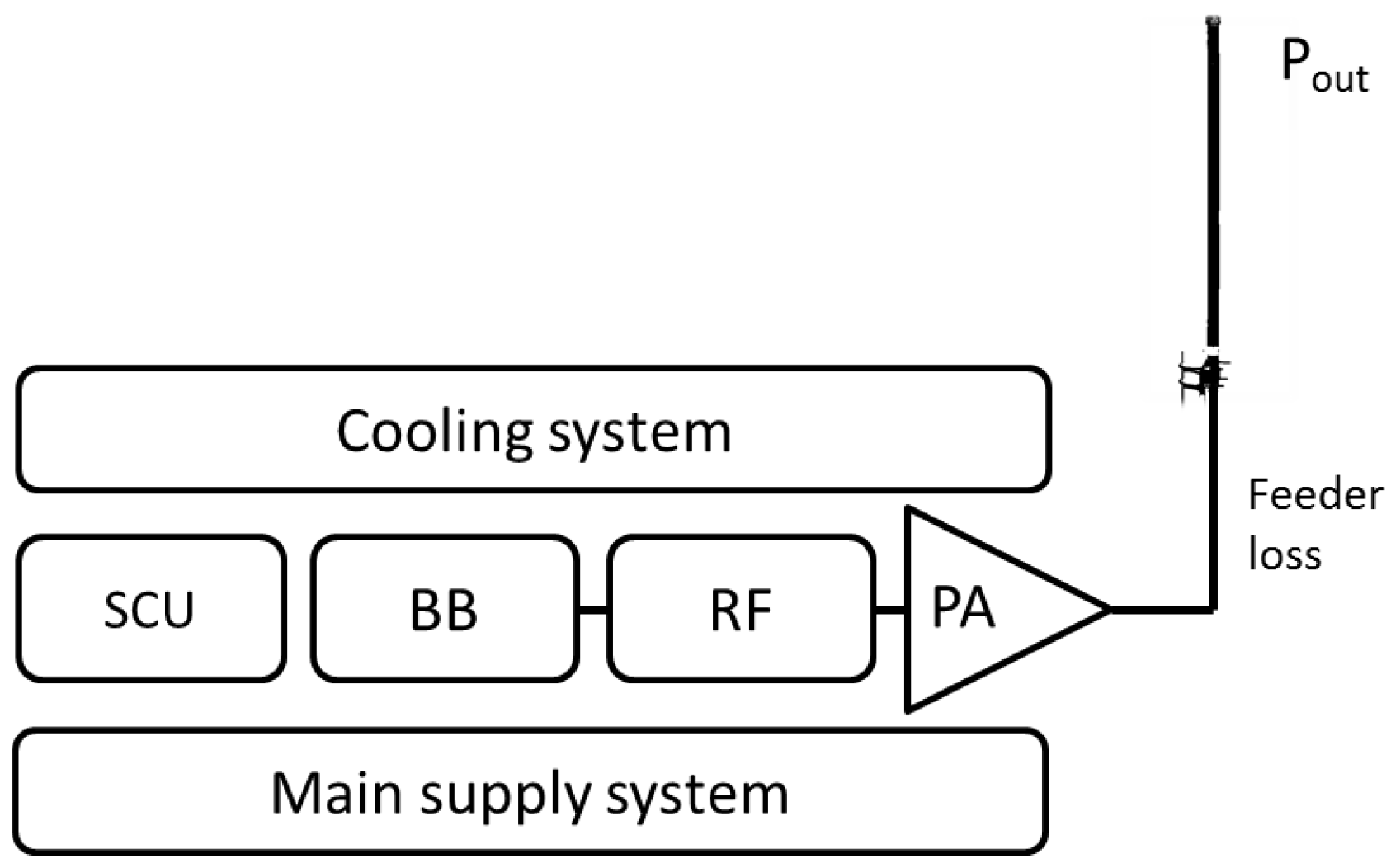
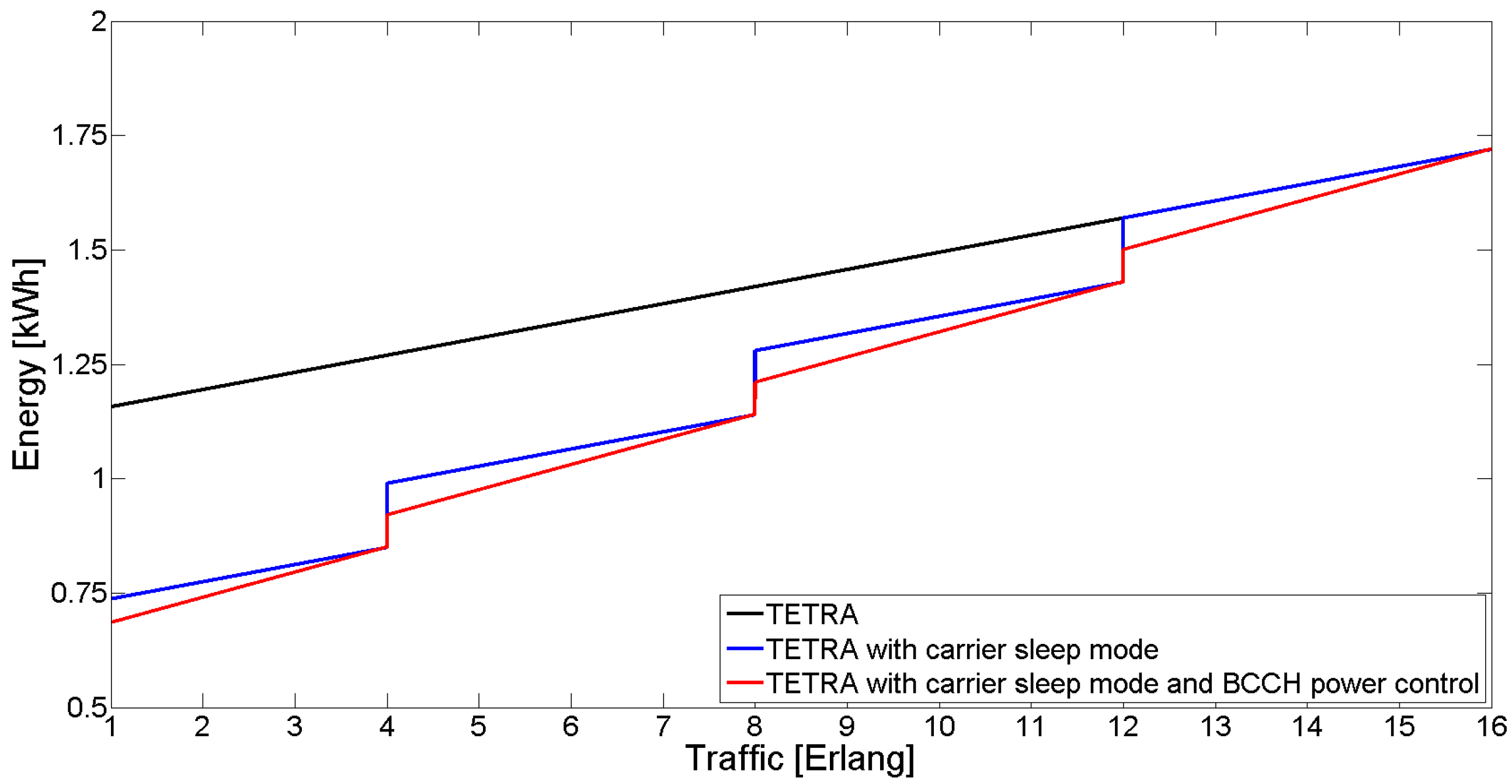
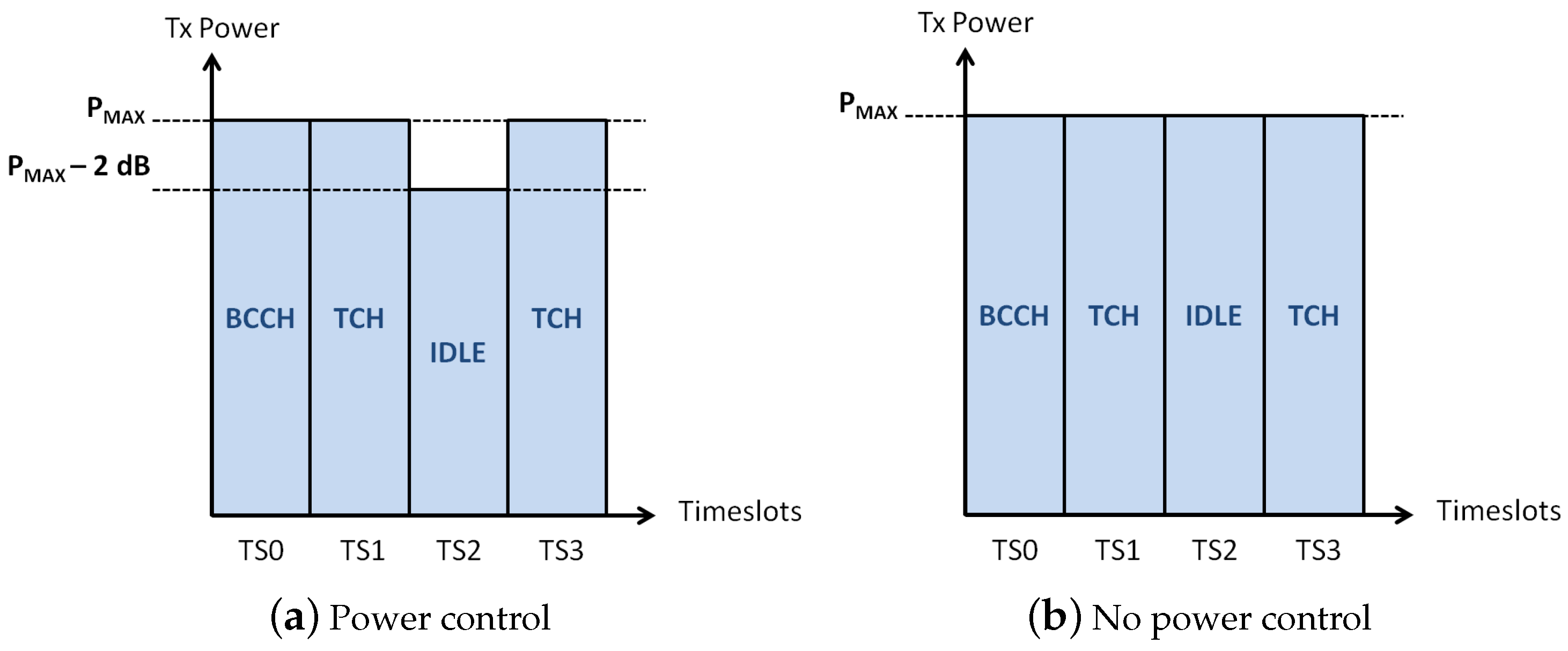
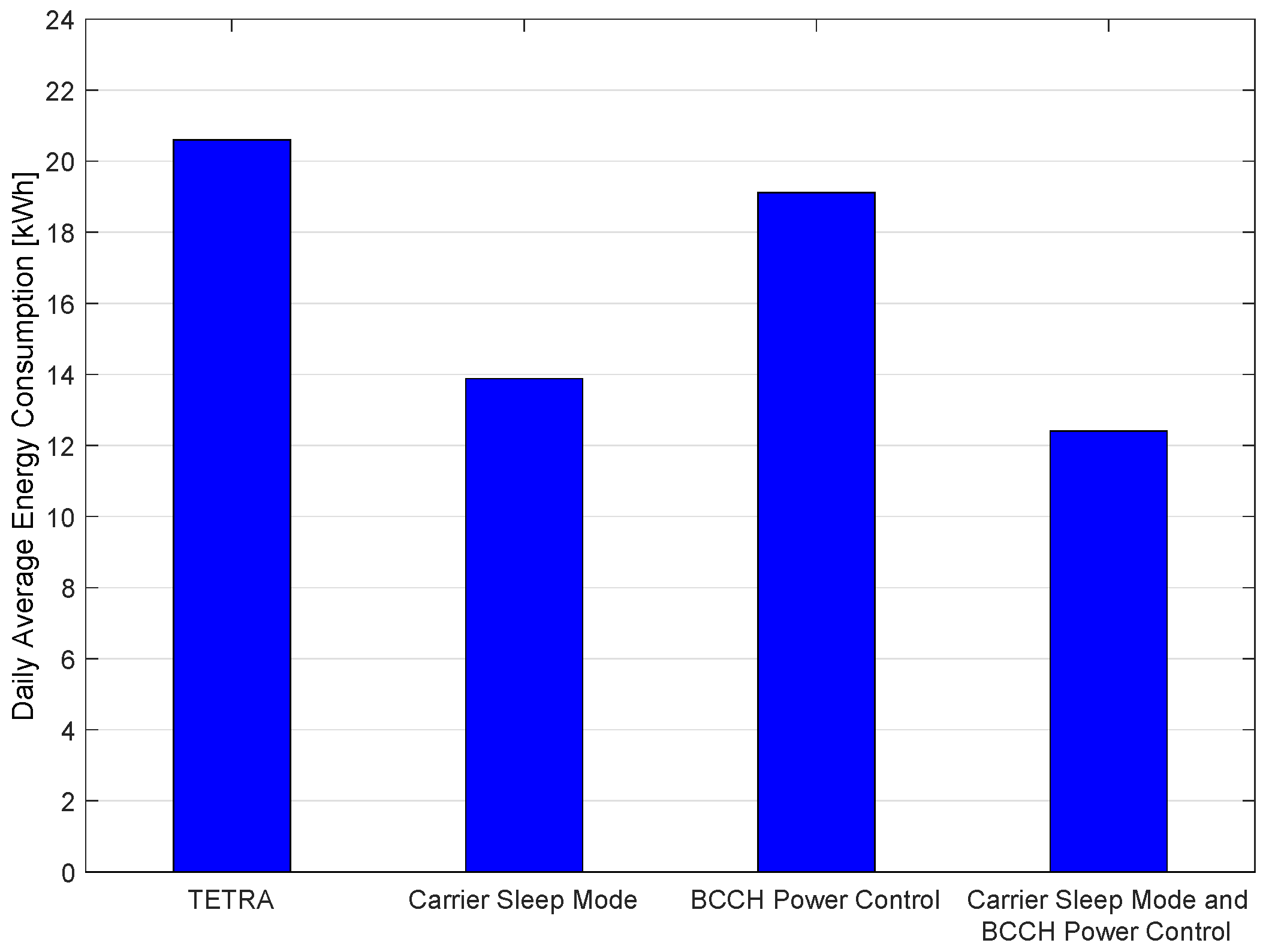
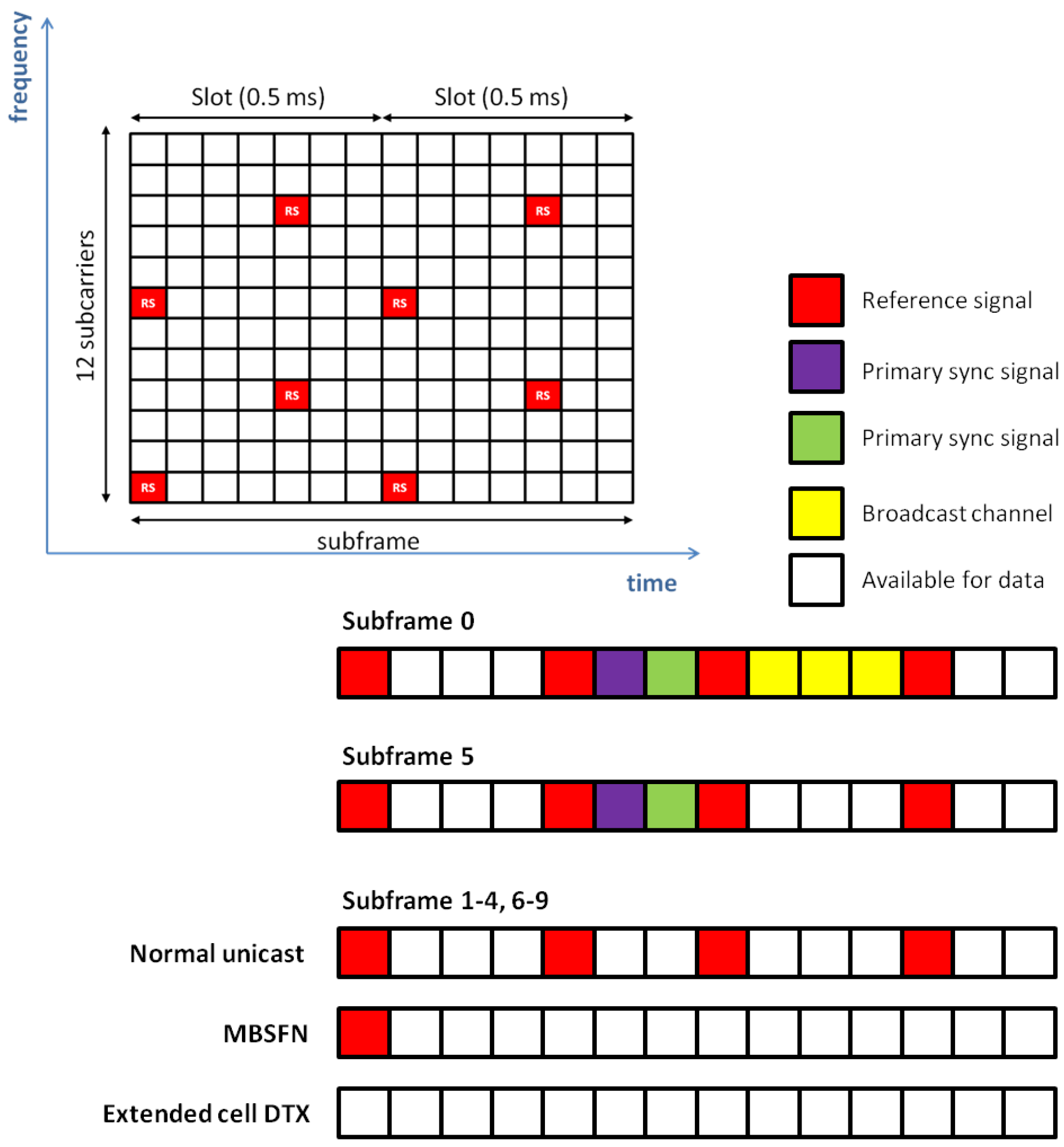
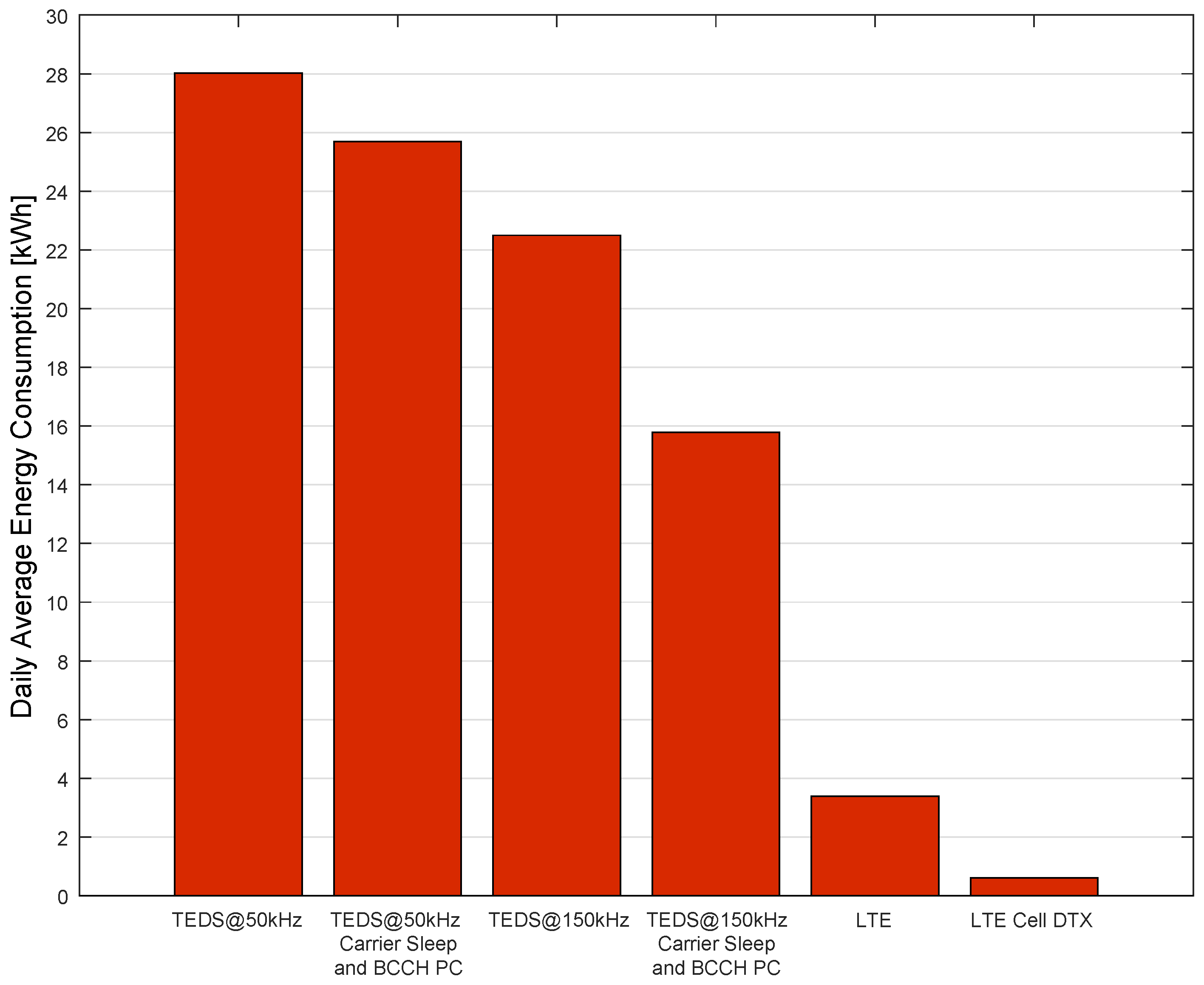
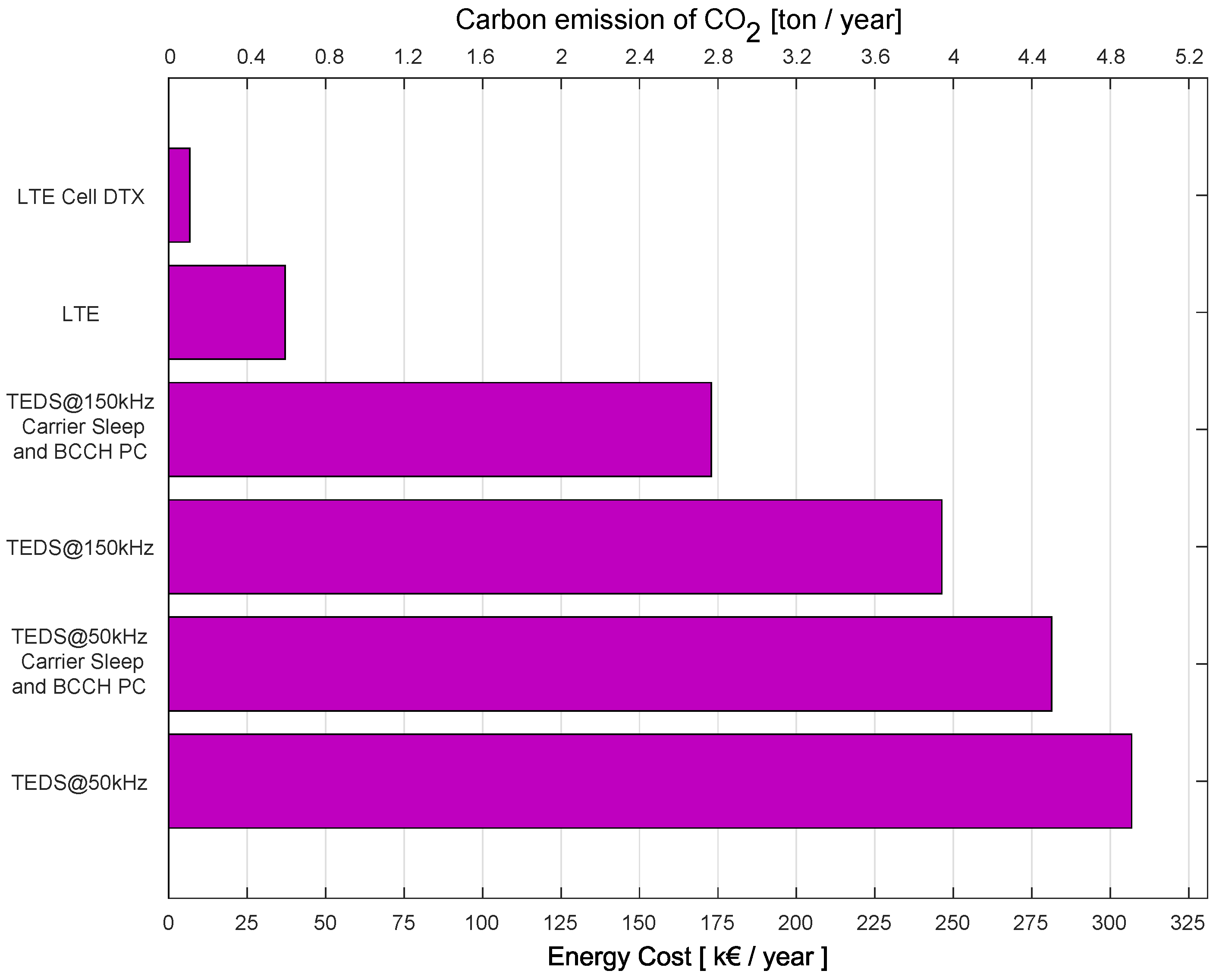
| 25 kHz | 50 kHz | 100 kHz | 150 kHz | |
|---|---|---|---|---|
| -DQPSK, r = 2/3 | 15.6 kbps | |||
| -D8PSK, r = 2/3 | 24.3 kbps | |||
| 4-QAM, r = 1/2 | 11 kbps | 27 kbps | 58 kbps | 90 kbps |
| 16-QAM, r = 1/2 | 22 kbps | 54 kbps | 116 kbps | 179 kbps |
| 64-QAM, r = 1/2 | 33 kbps | 80 kbps | 175 kbps | 269 kbps |
| 64-QAM, r = 2/3 | 44 kbps | 107 kbps | 233 kbps | 359 kbps |
| 64-QAM, r = 1 | 66 kbps | 160 kbps | 349 kbps | 538 kbps |
| Transmission power | W | |
| Power Amplifier (PA) efficiency | 0.25 | |
| Radio Frequency (RF) power consumption | 114 W | |
| Baseband (BB) power consumption | 75 W | |
| Site Control Unit (SCU) power consumption | 23 W | |
| DC loss | 7.5% | |
| Feeder loss | 50% | |
| Main supply loss | 9% | |
| Cooling loss | 10% |
© 2016 by the authors. Licensee MDPI, Basel, Switzerland. This article is an open access article distributed under the terms and conditions of the Creative Commons Attribution (CC BY) license ( http://creativecommons.org/licenses/by/4.0/).
Share and Cite
Dolfi, M.; Morosi, S.; Piunti, P.; Del Re, E. Energy Efficiency Perspectives of PMR Networks. Information 2017, 8, 1. https://doi.org/10.3390/info8010001
Dolfi M, Morosi S, Piunti P, Del Re E. Energy Efficiency Perspectives of PMR Networks. Information. 2017; 8(1):1. https://doi.org/10.3390/info8010001
Chicago/Turabian StyleDolfi, Marco, Simone Morosi, Pierpaolo Piunti, and Enrico Del Re. 2017. "Energy Efficiency Perspectives of PMR Networks" Information 8, no. 1: 1. https://doi.org/10.3390/info8010001
APA StyleDolfi, M., Morosi, S., Piunti, P., & Del Re, E. (2017). Energy Efficiency Perspectives of PMR Networks. Information, 8(1), 1. https://doi.org/10.3390/info8010001






